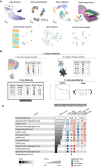This is a preprint.
Defining and benchmarking open problems in single-cell analysis
- PMID: 38645152
- PMCID: PMC11030530
- DOI: 10.21203/rs.3.rs-4181617/v1
Defining and benchmarking open problems in single-cell analysis
Update in
-
Defining and benchmarking open problems in single-cell analysis.Nat Biotechnol. 2025 Jul;43(7):1035-1040. doi: 10.1038/s41587-025-02694-w. Nat Biotechnol. 2025. PMID: 40595413 No abstract available.
Abstract
With the growing number of single-cell analysis tools, benchmarks are increasingly important to guide analysis and method development. However, a lack of standardisation and extensibility in current benchmarks limits their usability, longevity, and relevance to the community. We present Open Problems, a living, extensible, community-guided benchmarking platform including 10 current single-cell tasks that we envision will raise standards for the selection, evaluation, and development of methods in single-cell analysis.
Conflict of interest statement
M.D.L. contracted for the Chan Zuckerberg Initiative and received speaker fees from Pfizer and Janssen Pharmaceuticals. S.G. has equity interest in Immunai Inc. D.B.B. is a paid employee of and has equity interest in Cellarity Inc. L.Z. has consulted for Lamin Labs GmbH. W.L. contracted for Protein Evolution Incorporated. From 2019 to 2022 A.A. was a consultant for 10X Genomics. From October 2023 E.D. has been a consultant for EnsoCell Therapeutics. O.B.B is currently an employee of Bridge Bio Pharma. J.B. has equity interest in Cellarity, Inc. J.S.R. reports funding from GSK, Pfizer and Sanofi and fees/honoraria from Travere Therapeutics, Stadapharm, Astex, Owkin, Pfizer and Grunenthal. D.W. has equity interest in Immunai Inc. F.J.T. consults for Immunai Inc., Singularity Bio B.V., CytoReason Ltd, Cellarity, and has ownership interest in Dermagnostix GmbH and Cellarity. S.K. is a visiting professor at Meta and scientific advisor at Ascent Bio, Inc. E.d.V.B has ownership interest in Retro Biosciences and ImYoo Inc and is employed by ImYoo Inc. A.T.C. is an employee of Orion Medicines. B.D. is a paid employee of and has equity interest in Cellarity Inc. A.G. is currently an employee of Google DeepMind. Google DeepMind has not directed any aspect of this study nor exerts any commercial rights over the results. R.L. is an employee of Genentech. V.S. has ownership interest in Altos Labs and Vesalius Therapeutics. A.T. has an ownership interest in Dreamfold.
Figures


References
-
- Plass M. et al. Cell type atlas and lineage tree of a whole complex animal by single-cell transcriptomics. Science 360, eaaq1723 (2018). - PubMed
Publication types
Grants and funding
LinkOut - more resources
Full Text Sources

